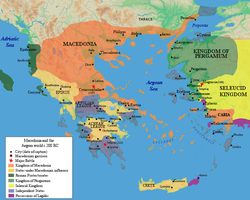Antigonids Antigonid Empire Ἀντιγονίδαι Antigonidai | |||||||||||||
|---|---|---|---|---|---|---|---|---|---|---|---|---|---|
| 306 BC–168 BC | |||||||||||||
 Antigonid Empire c. 200 BC | |||||||||||||
| Capital | Antigonia (Antigonus I) Demetrias (Demetrius I) Pella (since Antigonus II) | ||||||||||||
| Common languages | Greek | ||||||||||||
| Religion | Ancient Greek / Hellenistic | ||||||||||||
| Government | Hellenistic monarchy | ||||||||||||
| Basileus | |||||||||||||
• 306 BC – 301 BC | Antigonus I Monophthalmus | ||||||||||||
• 179 BC – 168 BC | Perseus of Macedon | ||||||||||||
| Historical era | Hellenistic | ||||||||||||
• Established | 306 BC | ||||||||||||
• Defeat by Rome | 168 BC | ||||||||||||
| |||||||||||||
The Antigonid dynasty (/ænˈtɪɡoʊnɪd/; Greek: Ἀντιγονίδαι) was a Macedonian Greek royal house which ruled the kingdom of Macedon during the Hellenistic period.[2] Founded by Antigonus I Monophthalmus, a general and successor of Alexander the Great, the dynasty first came to power after the Battle of Salamis in 306 BC and ruled much of Hellenistic Greece from 294 until their defeat at the Battle of Pydna in 168 BC (Third Macedonian War), after which Macedon came under the control of the Roman Republic.
The wars of the Diadochi witnessed the fall of the Argead dynasty in Macedon resulting in a power vacuum, which the Antigonid and Antipatrid dynasties sought to occupy. The Antigonid family first rose to power when Demetrius I Poliorcetes, son of Antigonus I, ousted Cassander's governor of Athens in 306 BC giving his father control over a land spanning from the Aegean Sea to the Middle East. Despite the subsequent instability and loss of the Asian territory, the family managed to maintain its power in mainland Greece and the islands, with Antigonus II Gonatas ultimately solidifying Antigonid rule over Hellenistic Macedon –a territory also known as the Antigonid Empire. Antigonus III Doson further expanded Macedonian influence in southern Greece reestablishing the Hellenic Alliance with himself as the president. Under Philip V, Antigonid Macedon first came into conflict with Rome, which had become a decisive power in the eastern Mediterranean. In the second century BC, the last Antigonid king, Perseus, became known as the champion of Greek resistance against Rome, albeit Rome's control over Antigonid Greece began to steadily expand, culminating in the fall of the dynasty in 168.[3][4]
- ^ Taagepera, Rein (1979). "Size and Duration of Empires: Growth-Decline Curves, 600 B.C. to 600 A.D.". Social Science History. 3 (3/4): 121. doi:10.2307/1170959. JSTOR 1170959.
- ^ Grant, Michael (1988). The Rise of the Greeks. New York: Charles Scribner's Sons. ISBN 978-0-684-18536-1.
It was the descendants of these Dorians [...] who formed the upper class among the Macedonians of subsequent epochs.
- ^ Nicholson, Emma (2023-01-20). Philip V of Macedon in Polybius' Histories: Politics, History, and Fiction. Oxford University Press. pp. 2–4. ISBN 978-0-19-269212-2.
- ^ "Antigonid dynasty | Britannica". www.britannica.com. Retrieved 2023-12-08.
![Tetradrachm with the Eagle of Zeus and the inscription ΒΑΣΙΛΕΩΣ ΠΕΡΣΕΩΣ, "[coin] of King Perseus" of Antigonid Macedonia](http://upload.wikimedia.org/wikipedia/commons/thumb/0/00/Perseus_of_Macedonia_Tetradrachm_90060057.jpg/175px-Perseus_of_Macedonia_Tetradrachm_90060057.jpg)